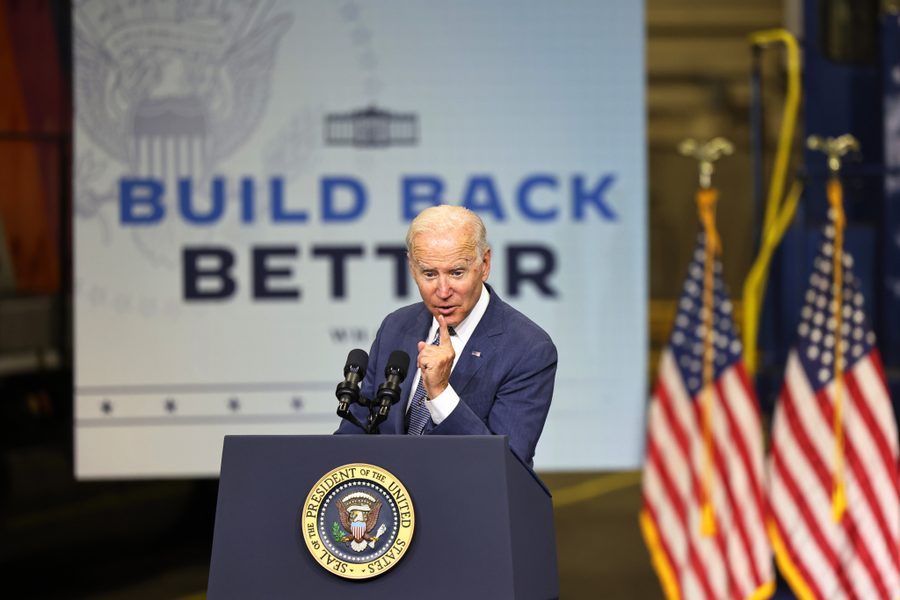Two Steps Forward, One Step Back: Grading Biden's Build Back Better Deal
What’s in the latest version of Biden and the Democrats’ massive social spending plan? Not everything progressives wanted, but more than might have been expected under a centrist president.
Max B. Sawicky

How good is the budget deal framework put forward by the Biden White House last week? It depends on your standard for comparison. Relative to Sen. Bernie Sanders’ (I-Vt.) opening bid of $6 trillion, or even the previous compromise of $3.5 trillion, it’s a drastic come-down, with a current price tag around $1.85 trillion.
But even before considering what is to come with the budget package, we ought to keep in mind what has already been done this year. In Fiscal Year 2021 (which ended in September), federal spending exceeded 30 percent of GDP. Presidents Trump and Biden share the credit for that outcome, since the fiscal year overlaps their times in office. Compared to past decades, such as 1975 to 1996 or 2003 to 2019, when federal spending hovered around 20 percent, that’s already a huge leap.
After taking office, the Biden administration came out of the gate quickly, winning passage of major legislation, including the American Rescue Plan, that increased the FY2021 deficit by $2.4 trillion. While Republicans like Mitt Romney decry this deficit spending, Biden’s proposed deficit of eight percent of GDP for 2022 pales in comparison to Donald Trump’s deficit of 15 percent of GDP in Fiscal Year 2020.
Summing up, in advance of next year’s budget, we are already ahead of the game in terms of social spending. Keeping in mind that the final package is still a moving target, here is where we’re at.
The good
Let’s start with the positives. The White House promotion of the budget framework is here. In what follows, we will endeavor some deconstruction.
Pre-K: Perhaps the greatest success in current negotiations is the provision of universal pre-K to the nation’s three- and four-year olds. Many progressives were understandably enthused with the $300-per-child-per-month expanded Child Tax Credit. But it is easy to imagine free pre-K offsetting an equal amount of expense for families with children of those ages.
What has received little notice so far is that pre-K will be under the purview of state and local governments, some of which, as Matt Bruenig points out, are run by politicians who will be hostile to the program. Implementation will bear no small amount of scrutiny going forward. The policy is threatened by a replay of red state rejections of pandemic expansions of unemployment insurance this past year or the Medicaid expansions provided under the Affordable Care Act.
Child care: Major subsidies on child care for families, albeit subject to high income phase-outs. However, even high thresholds require everybody to document their income, or lack thereof, which could make qualification an issue for some poor families.
Child Tax Credit: A one-year extension of the program, providing members of Congress with the tantalizing question of whether they want to oppose further extension of this benefit, which has already greatly reduced childhood poverty, in an election year.
Climate change: Tax credits for use of carbon-free renewables, amounting to the largest investment in climate change mitigation in U.S. history, plus making it easier for you to buy that Tesla you’ve had your eye on. The plan also includes funding for a Civilian Climate Corps, taking after the Civilian Conservation Corps of the Great Depression.
Healthcare: Medicare beneficiaries will get more support for hearing aids. Prices for hearing aids have come down, but unless you get one of those miracle gadgets from the internet, you are still looking at a thousand or so dollars in costs. Beneficiaries under the Affordable Care Act will also get increased subsidies to buy health insurance.
The saving grace in this regard is that both programs provide a foundation upon which greater resources can be placed. In policy wonk language, they are “scalable.” Naturally, we could have wished for upscaling.
Unfortunately, Sanders’ call for Medicare to cover dental benefits for seniors has apparently fallen by the wayside. But on the plus side, dental and vision coverages were added to Medicaid.
The Earned Income Tax Credit: The previous expansion will be extended, and the benefit for workers without children will be tripled. This program has been criticized from the left because it requires employment and the benefits phase out at modestly higher income levels. The problem with that criticism is that those features are the price of having the program in the first place. Whatever its shortcomings, the EITC does reduce poverty.
Etc: Much more dough for housing, “seniors in need,” and Pell Grants.
Shrinking the tax gap: On the revenue side, one item to celebrate is an infusion of increased support for the Internal Revenue Service, effectively ending a 20-year campaign by Congress to cripple the agency’s enforcement capability. By available estimates, the investment in the IRS will more than pay for itself in increased collections of taxes owed but not paid on time, or ever, in the amount of $400 billion. The extent of the annual, total revenue loss is estimated to be about 15 percent of what is owed and is known as the “Tax Gap.”
The bad
The chief excuses for downsizing the Sanders plan and the budget resolution are alleged concerns over deficits and inflation. Regarding deficits, the display of hypocrisy is stunning. Nobody can remember Republican complaints about deficits when Republican presidents requested higher ones, nor criticism of the bipartisan infrastructure plan, of which half a trillion dollars is “not paid for.”
It is interesting to note that a thorn in the side of Biden’s proposals has been Sen. Kyrsten Sinema (D-Ariz.), who voted against tax cuts enacted during the Trump presidency. She now says she opposes the tax increases that would result from clawing back the tax cuts that she opposed in the first place.
A somewhat novel development is concern over inflation, voiced by fellow Biden thorn Sen. Joe Manchin (D-W.V.). It should be noted that inflation has been warned of as a negative consequence of deficit spending since the 1930s. A basic principle in economics was the idea of the “Non-Accelerating Inflation Rate of Unemployment.” Underlying that mouthful is the belief that if unemployment gets too low, a hyperinflationary spiral ensues, wreaking untold chaos. In past years, the minimum tolerable unemployment rate was presumed to be as high as six percent. Conservative economic guru Milton Friedman once wrote that “We are dangerously close to full employment” in a period of the long-term decline of inflation.
Historical experience has totally demolished this theory, or at the very least, belief in the six percent minimum. More recently, in 2010, the crème de la crème of conservative economists penned a letter to the Federal Reserve warning of the inflationary consequences of its “quantitative easing” program, under which the Fed buys financial assets to get more cash into circulation. But in fact, there were none. These conservatives also expressed skepticism that the policy would promote employment. In actuality, employment grew without interruption after 2010. The wonder is that these people still think they should run the economy.
Interest rates are thought to reflect expectations of inflation. The most recent rate for the Personal Consumption Expenditure deflator indicates a year-over-year inflation rate of 4.3 percent. The Chairman of the Board of Governors of the Federal Reserve recently forecast a rate of 2.2 for 2022. Two percent is regarded as ideal. Recently, there has been worried talk of a sustained rate of three percent. The threat is underwhelming. We have survived such rates in the past. In 2011, for instance, the rate was 3.8 percent.
The other deficit bugaboo is that deficits will kick up interest rates and stifle business investment. This alarmist talk began in the 1980s and reached full flower in the 1990s. It too proved to be bunkum. If the scare stories about inflation were taken seriously by the bond market, it would be observed in interest rates. The data does not indicate any great danger.
Critics of expanded social spending often demand that increases be offset by some combination of cuts in other programs or revenue increases, also known as “pay-fors.” (That constraint is never applied to defense spending.) The problem is that program cuts are unpopular, and in the current budget wars, a fringe of right-wing Democrats opposes tax increases. So efforts to stimulate the economy are checkmated. This has resulted in the shrinking in proposed spending from $3.5 trillion to the current level of $1.85 trillion.
One of the larger pay-fors that has been taken off the table is the option of Medicare bargaining with pharmaceutical companies over drug prices. Ironically, this is one of the most popular pay-fors, as far as the public is concerned. Alas, Big Pharma lobbyists and their largesse have assembled the small number of opponents required to scuttle the policy, given the razor-thin Democratic margins in the Congress. Sinema, harvesting lobbyist donations hand over fist, is prominent among them, though she is not alone.
The ugly
A medley of popular causes has fallen by the wayside altogether in the current framework, among them free community college, Medicare benefits for dental and vision care and paid family leave. Many environmental advocates question the adequacy of the commitment to combating climate change. Medicare for All was never in the mix. The $15 minimum wage has already been torpedoed by Senate Majority Leader Chuck Schumer’s (D-N.Y.) obedience to the unelected Senate parliamentarian, who is actually his employee.
In a posture reminiscent of the worst moment of the Obama administration, Biden is touting the deficit-neutral nature of the plan — claiming that the entirety of new spending is “paid for.” This may be an exaggeration, but more to the point, it’s a bad look for Democrats. The ‘paid-for’ result is a bug, not a feature. In light of persistent employment gaps, it’s too soon to launch the misbegotten fiscal responsibility of deficit reduction. Even relatively conservative outlets, such as the Brookings Institution and the Congressional Budget Office, project continued economic growth with Biden’s proposed budget, notwithstanding the anticipated growth in public debt.
A similar moment transpired in 2010 when then President Obama took credit for fiscal restraint at a point when the economic recovery was proceeding at a snail’s pace. The administration had a case for saying they did as much as Congress would allow, but it would have been far better to admit that more should have been done, rather than resting on laurels that were swept away and resulted in the Democrats losing control of Congress in that year’s midterm elections.
Another consequence of that fruitless self-imposed fiscal restraint was the near-death experience of the Affordable Care Act, whose inadequate subsidies for the purchase of insurance are only now being addressed. Unhappiness over the subsidies under the ACA was another factor that could not have helped Democrats’ political fortunes after 2010.
As it stands, after all the program deletions noted above, the remaining programs in the $1.85 trillion package will “sunset,” or end, before the revenue increases enacted as pay-fors do. This means that under this “buy now, pay later” plan, survival of the social programs will require additional votes in Congress to reauthorize, along with more votes for pay-fors.
There has been debate in Washington over the political merits of enacting a smaller number of programs in ideal form, which means at greater cost, or spreading available resources over a larger number of programs with assorted, undesirable ways of limiting cost, such as means-testing and work requirements.
On the one hand, fewer, better programs should last longer and inspire greater political support from beneficiaries. On the other, a wider dispersion of program benefits may motivate support from a greater number of beneficiaries and Democratic constituencies. The Democratic Congress has apparently settled on the latter option.
In The American Prospect, David Dayen argues that the fragmentation of the money into numerous, smaller programs reduces the appeal of the largest ones. In this respect, the resulting bill satisfies individual members of Congress pursuing assorted projects — things desired by well-meaning advocates that the members can hang their names on — at the expense of more ample funding for the big ticket items like the Child Tax Credit.
Regardless of the wisdom of the decision, Democrats in Congress are generally better judges of their own political best interest, if not necessarily ours.
Two steps forward, one step back
Getting back to standards for comparison, if you had told me in 2020 that a President Joe Biden — a lifelong, dedicated deficit-phobe—would finalize a one-year increase in the deficit of $2.4 trillion, plus engineer another $1.85 trillion in social spending, including $500 billion for climate change mitigation, plus over $500 billion in added infrastructure spending, I would have been pleasantly surprised. In this respect, the Biden administration has gone some ways towards turning the Covid crisis into opportunity.
A better standard is how much more, if anything, might have been possible. In a 50-50 Senate, two recalcitrant Democrat senators — Manchin and Sinema — are a serious obstacle. In some respects, these two might be shielding additional backsliders. For instance, Democratic Sen. Bob Menendez of New Jersey might have stepped up by himself to block prescription drug reform, if not for Manchin and Sinema.
The hope is that the package will help save Democrats’ bacon in next year’s midterms. In the absence of that, election security in 2024 with Donald Trump or some neo-fascist facsimile at the top of the Republican ticket will be a huge headache.
We should not forget that other battles remain. Once the budget is wrapped up, the Biden administration can focus more on regulatory activism, using its control of the executive branch substantially beyond the constraints of Congress. Rebecca Leber at Vox discusses potential regulatory action in the field of climate change to compensate for what has been left out of Biden’s budget proposals. There is also the possibility of student debt relief, potentially feasible by executive order. Perhaps the highest priority is securing voting rights.
In the past, grassroots mobilization has spurred action by Congress. Even if this budget package passes, warts and all, we will still need a lot more agitation to further a progressive political revival.
Max B. Sawicky is an economist and writer in Virginia, formerly with the Government Accountability Office and the Economic Policy Institute. He is a Senior Research Fellow at the Center for Economic and Policy Research and runs the MaxSpeak, You Listen! blog at sawicky.substack.com.








